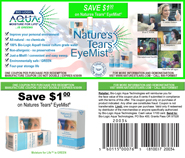
Dry Eye Symptoms
No dry eye definition includes an exact physiologic cause; instead eye doctors look for a series of symptoms.
Defining Dry eye.
It may be called "dry eye," "red eye," "computer vision syndrome (CVS)," "allergy eye," "irritated eyes," "tired eyes," "sore eyes," "itchy eyes," "puffy eyes," or "swollen eyes." Whatever the name, Dry eye is a dehydration disease experienced by nearly everyone and is on its way to becoming a global health crisis. In the United States, dry eye symptoms are among the most frequently cited reasons for visiting the eye doctor.
The symptoms of dry eye are so common that eye doctors find it difficult to draw a precise line between "normal" eyes, and "abnormal" eyes with dry eye disease. Occasional dry eye is normal and experienced by most people at one time or another. Since their symptoms are usually transient and not severe, the majority do not seek medical therapy or attempt treatment.
There is considerable disagreement about the precise clinical definition of dry eye syndrome as a disease and about the precise physiologic cause. No physiologic variable correlates exactly with either chronic dry eye symptoms or transient dry eye symptoms, although most measurable variables correlate to some degree. Instead, physicians look for a series of symptoms. The presence of one or more symptom could indicate a dry eye condition.
Common dry eye symptoms.
- Eye irritation
- A sensation of dryness in the eyes
- Burning eyes
- Scratchy or grainy eyes
- Blurred vision (especially late in the day)
- Fatigue
- Headache
- Stiffness of the neck or shoulders
- Puffy eyes
- Red eyes
- Watery eyes
Symptom based dry eye definition
A symptom-based definition works reasonably well. The degree and duration of symptoms are critical since a large percentage of the adult population (including 50% of adult females) complain of at least mild dry eye symptoms at any given time.
In addition to symptoms, most (but not all) dry eye patients have at least one physiologic parameter that lies significantly outside the range of normal. This could include an excessively thin or "blotchy" lipid (oil) layer overlying the tear film or malfunctioning meibomium or lachrymal glands. Typically, tear production has decreased, tear film volume is low, water evaporation is high, and/or tear osmolarity is elevated. Tears produced by "dry eyes" may contain elevated levels of substances (metalloproteases and other proteinaceous compounds) that increase surface inflammation.
There may also be environmental factors present that create a high risk for dehydration diseases. These include daily exposure to dry air, low humidity air or polluted air, or to indoor forced-air heating and cooling.
The power of proactive thinking.
As a patient, it is critical that your doctors not only informs you that you have "dry eye" based on symptoms, but also identifies:
- Which "physiological parameters" lie outside the range of normal.
- The presence of high risk environmental factors.
- Recommended diet, nutrition and lifestyle choices to improve your overall health and hydration.
If your doctor does not tell you these things, IT IS UP TO YOU TO ASK (Or better yet, come to the examination prepared with a list of symptoms and questions). This information can make a substantial difference in the choice of treatment modes and in lifestyle changes that will decrease risk exposure and symptoms.
Source: WD Mathers, MD, Tear Film and Treatment of Dry Eye Disease, © 2004 RxSchools.com. Funded and sponsored by Bio-Logic Aqua Research (Bio-Logic Aqua Technologies) and Nature's Tears® EyeMist®.









